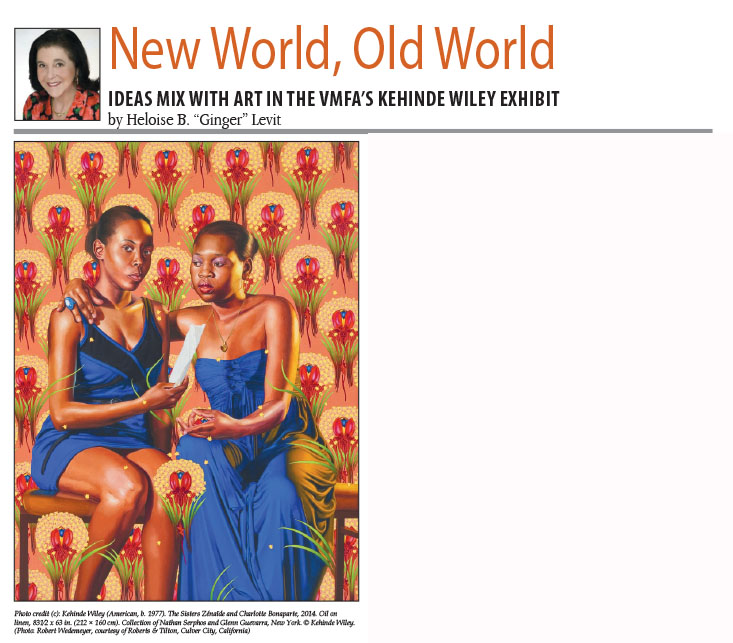
What a clever idea: Digging deep into European art history while pursuing a master’s degree at Yale. That knowledge, combined with a variety of current factors and influences, resulted in what some experts consider to be a new commentary, a new definition of art history, a rearrangement of values as perceived by a talented painter.
In his work Kehinde Wiley religiously reuses the poses and glances of various historical characters, created on canvas by such previous great masters as Franz Hals (Dutch 1585-1666), Hans Holbein (German 1497-1543), Jacques-Louis David (1748-1825) and Théodore Gericault (1791-1824).
Wiley, however, dresses his mostly African American heroes and heroines in contemporary clothing while emulating the regal poses of their historic predecessors. His Napoleon is clothed in modern camouflage gear and high sneakers, with a bandana on his head instead of a military hat. The background of this imposing 108-by-108-inch canvas is dark red, with a pattern of gold medallions. Nearly every painting has a bright floral patterned background.
The long awaited exhibition “Kehinde Wiley: A New Republic,” attracting enormous crowds, has finally arrived at the Virginia Museum of Fine Arts where it will be on view through Sept. 5, 2016. It originated last year at the Brooklyn Museum; it will then travel to a total of seven museums before it closes in late 2017. The retrospective invites discussion of race, identity and the politics of representation.
VMFA Director Alex Nyerges comments: “ Race, gender, preference and so many other factors of life influence his work. It is clearly heavily impacted by both race and racial conflict. It offers hope and elegance for all.”
The viewer ponders, “What is going on here?” The 55 mostly huge paintings, glass and sculpture are so reminiscent of 18th-century classicism. The earlier figures, not on view here but found in the interesting exhibition catalog, are dressed in the clothing of their era. In the exhibition, notice the dignity as Napoleon goes riding off on his charger. Wiley’s 21st century African American version is dressed in is own contemporary clothing, but he is equally dignified. Is the artist making a commentary here, stating that his subjects are on a par with great leaders, qualified to step into the shoes of their famous predecessors?
Wiley chose his subjects with great care, stepping out onto the street where his Brooklyn studio was located, surveying and chatting with the pedestrians as to their suitability for what he had in mind. He would then invite the selected prospect to his studio where they looked at art history books, trying to find a figure striking an interesting pose.
He had been exposed to art at an early age. Noticing his interest in art, his mother sent him to Russia where he could study the masterpieces at the Hermitage. He obtained a master’s from Yale, then became artist in residence at the prestigious Studio Museum in Harlem.
The exhibition opens with former VMFA curator John Ravenal’s choice for the VMFA’s collection, a portrait of William van Heythuysen who was originally painted by Franz Hals (1581-1666). Wiley’s figure’s stance is identical to the original by Hals; so is the authoritative facial expression. Also, notice Wiley’s use of light—the figures seem to be aglow. “His use of light is indeed masterful,” Nyerges said. “He has studied the best of the old masters and the classical training has informed him well. Moreover, he has captured and perfected the light of the Baroque and the Grand Manner like few others.”
Another intriguing horse painting portrays Michael Jackson in an 188th-century ornate gilded military cape and suit. Two angels dance in the clouds above his head. A landscape and other buildings loom behind him. Other paintings document Wiley’s travels to northern Africa and France. Always searching for new ideas, he embarked upon several series; a few paintings depicting sisters are especially charming.
In his remarks at the VMFA opening, Wiley delivered a rather biographical lecture with a few questions to ponder. Many of the answers just might be found while looking at the exhibition.
Héloïse “Ginger” Levit is a private art dealer who also writes about art and travel for several publications. Contact her at gingerlevit@comcast.net.